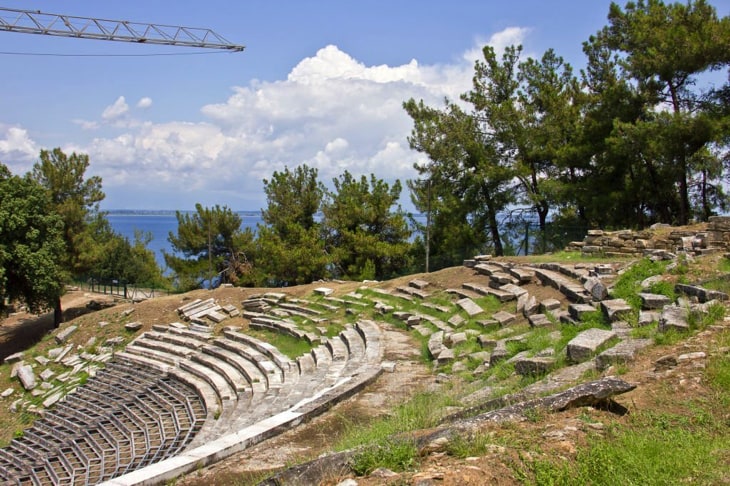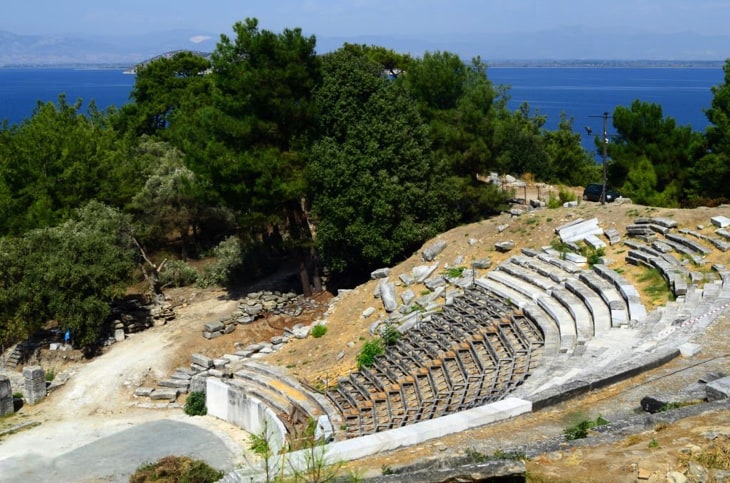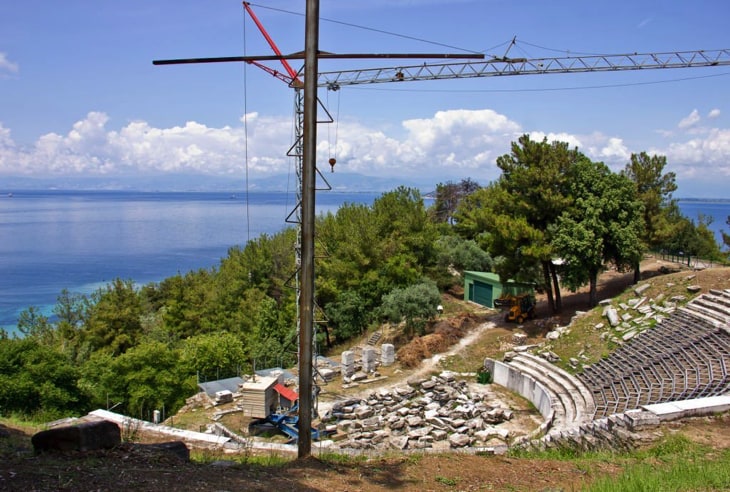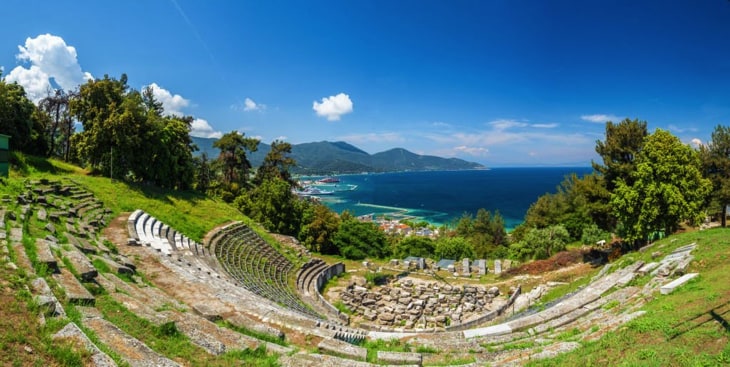Are you looking for a fun and immersive way to experience the ancient culture of Thassos? Then look no further! You can take in the historic sounds and sights of Thassos by visiting this ancient theatre. Built on the 4th century BC, The Ancient Theater of Thassos is rich with history just waiting to be explored.
Situated on a natural hillside overlooking the crystal-clear waters of the Aegean Sea, this ancient site is perfect for those seeking to explore Greece’s vibrant cultural heritage. From the marble seats to the charming scenery and grand scale of the theatre itself, you will be amazed every step of the way. Climb up its curved steps and take your seat while imagining what it would have been like to watch shows that go back centuries ago. The Ancient Theater of Thassos will provide an unforgettable adventure of discovery and has something to offer to everyone looking for an exciting getaway!
Also read: Best Historical Sights and Landmarks In Thassos
Historical Context
The theatre of Thassos, constructed during the Hellenistic period, is an impressive testament to its ancient heritage. Dating back to the late fourth century BC, the initial stage of construction saw a dedicated stage building with a marble façade. In honour of Dionysus, the Thassian Lysistratos erected a Proskenion with twelve supporting columns. Each one was fluted along three-quarters of its circumference and featured intricate notches for scenery manipulation onstage. Making up the facade were elements in a Doric style, like multiple sections of architraves, capitals, and metopes – some of which have been preserved to this day. It is plain to see that even thousands of years after its construction, the beauty and impact of this ancient site remain unparalleled.
Architectural Features
The Ancient Theater of Thassos is an impressive structure that has stood since the 4th century BC. The theatre was built using typical construction methods and materials of the day, such as stone and mortar. This method of construction was a common practice in ancient Greek theaters, which were usually fashioned into naturally occurring hillsides or mounds with curved seating sections facing the raised stage area. Though possibilities exist for further elements or design features for this theatre, we may never know unless additional information comes to light.
Also read: Thassos Architecture: Distinctive Features & Influences
Construction & Design
The Koilon, a prominent feature of the ancient city landscape, has been preserved in the form of a semicircle. It is thought to have its roots in Roman times, with evidence of its long-standing existence coming in the form of marble-clad retaining walls and asymmetrical, convergent design. The seats are made from flat marble blocks, bar those located in the lowest section that features engravings containing the names of individuals or families who were allotted specific seating areas. Three radiating stairs divide the Koilon into four distinct parts, with no room for a diazoma at any point. It only goes to show how important and meaningful this space was to people of different backgrounds back through antiquity.
During the Roman dynasty of the Severans (late 2nd to early 3rd century AD), theatres began to be transformed into arenas for animal hunts and gladiator fights. Some of the striking features of this transformation are still evident today, most notably the heavy door thresholds used to close off the side entrances. Additionally, around 140 BC, Eragoras and his wife erected a parapet with a balustrade along the orchestra in order to keep spectators safe – many of these posts have been restored back to their original positions in order to preserve the theatre’s original state. Lastly, the construction crew flattened out the slope of the new Koilon in order to give audience members a better view of the arena – this was a common practice done during arena conversions from former theatres.
The stage building of the Amphitheatre was transformed during its renovation; large marble supports adorned the facade, while Doric elements could be found scattered throughout. Though the Proskenion had to be dismantled, it was tidied up and then put back in place not long after. The plain metopes on the frieze were even carved with figures of gods like Dionysos and Ares. Even more impressive were the pillars located at both ends of the Proskenion front colonnade; Eumerius, son of Dionysios – rumoured to be a gladiator himself – paid homage to the fateful Nemesis in a bas-relief on the southern pillar. Evidently, even other gladiators got in on this trend as they, too, added bas-reliefs of Nemesis to walls within the stage building.
Function & Purpose
The Ancient Theater of Thassos is a stunning reminder of a past era when community-based performance and religious spaces were paramount to daily life. Built in the 4th century AD, the open-air structure was used to provide entertainment for the people of Thassos – plays, concerts, and political assemblies were likely all popular events held at the theater. Archaeological evidence also points to its possible use as a sacred space – religious ceremonies or civic events may have been hosted at the site. The Ancient Theater of Thassos has seamlessly stood the test of time, transcending its original purpose to become a beloved piece of history that still has much to offer today.

Cultural Significance
The ancient Theater of Thassos has great cultural significance for many reasons. Its sturdy architecture showcases the talents of the Greek architects and builders from centuries ago, offering a rare glimpse into the originality and creativity of ancient theatre design. As one of the world’s oldest surviving dramas, it is an essential part of our shared heritage that continues to astound visitors. Beyond its obvious architectural significance, the theatre also serves as a modern cultural center dedicated to keeping alive the distinct culture and customs that make Thassos unique. Whether it be through performances and events or simply as a destination for travellers hoping to take in some history, this theatre helps to preserve the area’s historical roots while captivating onlookers with its remarkable perseverance.
Also read: Geography of Thassos
Artistic Influences
The ancient theatre of Thassos is notable for its intricate artistic influence. Ancient masks from the playwright Thespis, stored in the Thassian Museum and dating back to the 4th century BC, have been proven to have elegant designs that reflect neoclassical architecture. Additionally, terracotta figures and instruments have been found at several excavation sites around Thassos, representing an ancient form of artistry that greatly affected theatre performance. Even fragments of frescoes remain, showcasing the importance of visual art and its relevance within Thassian theatrical culture. These artefacts indicate how important artistic influence was in shaping and enhancing ancient theatrical events in Thassos – ultimately allowing us to understand the complexities of this unique theatre medium.

Preservation & Restoration
The ancient theatre of Thassos has managed to retain its grandeur for many centuries, but it is still threatened by erosion and weathering caused by the elements. For this reason, preservation and restoration efforts are paramount. In recent years, the government of Greece has funded research and restorative projects to protect this precious piece of cultural history. Steps have been taken to halt further damage while also preserving features such as arches, columns, and staircases.
The second phase of the theatre’s restoration includes some significant projects like restoring its concave, a large section of marble seats, reinforcing the eastern bridge, restoring part of the foreground, improving accessibility for those with disabilities, and creating a virtual tour. This vital project is funded by Greece’s National Strategic Reference Framework (NSRF) and implemented by Kavala-Thassos’s Ephorate of Antiquities.
Ultimately, preservation and restoration practices will enable generations to come to appreciate this impressive structure as a tangible representation of ancient civilization and culture.
Events & Performances
The ancient theatre of Thassos is a true testament to its long and celebrated history. The ancient acropolis of Thassos has been used for centuries as a center for cultural events, but modern Thassians have taken it one step further. Host to the local festival each year, the theatre provides locals and visitors alike with an experience that brings the community together. With a panoramic view and an impressive capacity for 2000 viewers, there’s plenty of room to enjoy musical performances, theatrical events, and more against a backdrop of stunning natural beauty.
Every summer, the Phillipi Festival takes place at the site and is renowned throughout Greece for its tremendous variety of performances. Top-tier theatricals from professional companies come to showcase their talents, as well as renowned Greek singers and local amateur bands. Smaller visitors also flock to the event, with children’s theatres putting on their own shows too. Visitors during the festival can experience an amazing show that accurately reflects the best cultural elements of Thassos. It’s no wonder why this incredible venue has been celebrated for centuries.
What is the significance of the Ancient Theater Of Thassos?
The Ancient Theater of Thassos is significant for a number of reasons. First and foremost, it is a well-preserved example of ancient Greek theatre architecture, offering valuable insights into the design and construction of these structures. As one of the oldest surviving theatres in the world, it is an important historical and cultural artefact. In addition to its historical and architectural significance, the Theater of Thassos is also an important cultural site. It has been used as a venue for a variety of cultural events and performances, offering a unique opportunity to experience the ancient culture of Thassos in a contemporary context. It is also a popular destination for tourists and history enthusiasts, helping to preserve and promote the rich cultural heritage of the region. Overall, the Ancient Theater of Thassos is a valuable and fascinating example of Greek history and culture, and its significance should not be underestimated.
Who used the theatre, and for what purpose?
It has been suggested that the theatre may have served a local audience rather than had international guests, as it consists of normal stone seats with little to no architectural grandeur. It is widely believed that the primary use of this theatre was for comedic performances, but archaeological evidence suggests that it was also used to host musical events such as orchestra concerts and drama festivals. Military parades have also been led down its steps, with some historians claiming that athletes presented their skills at certain contests within its walls. It certainly served many purposes throughout its long-standing life, playing an important role in the community of Thassos back then.
Who financed the construction of the theatre?
It is not clear who specifically financed the construction of the Ancient Theater of Thassos. In ancient Greece, theatres were typically built and funded by wealthy individuals, city-states, or governments. It is possible that the Ancient Theater of Thassos was funded by one or more of these entities, but without further information, it is not possible to determine the specific individuals or organisations that provided the financial support for its construction.

How was the Ancient Theater Of Thassos used?
The Ancient Theater of Thassos was likely used for a variety of purposes, including plays, concerts, and political assemblies. As an open-air structure, it would have been a popular gathering place for the people of Thassos to enjoy a variety of cultural and artistic events. It is also possible that the theatre was used for other purposes, such as religious ceremonies or civic events.
How was the Ancient Theater Of Thassos built?
However, it is likely that the theatre was built using traditional construction methods and materials of the time, such as stone and mortar. Ancient Greek theatres were typically built into a natural hillside or raised artificial mounds, with rows of stone seats facing a raised stage area. It is also possible that the Ancient Theater of Thassos incorporated unique features or design elements, but without further information, it is difficult to say for certain.
How old is the Ancient Theater Of Thassos?
The Ancient Theater of Thassos is likely quite old. It is estimated to have been built in the 4th century BC, making it over 2,300 years old. As one of the oldest surviving examples of Greek theatre architecture, the Theater of Thassos is a valuable and fascinating piece of history.
What is the history of the theatre, and how did it come to be?
The theatre of Thassos stands as a magnificent testament to its ancient heritage. It was constructed during the Hellenistic period, dating all the way back to the late fourth century BC. The initial stage of construction saw a dedicated stage building with a marble façade, and in honour of Dionysus, Lysistratos erected a Proskenion containing twelve supporting columns.
Where is the Ancient Theater of Thassos located?
The Ancient Theater of Thassos is located on the island of Thassos in the Northern Aegean Sea. Thassos is a small, picturesque island located just off the coast of mainland Greece, and it is known for its beautiful beaches, ancient ruins, and rich cultural heritage. The theatre is situated on a natural hillside overlooking the Aegean Sea, providing stunning views of the surrounding landscape.
How to get to the Ancient Theater of Thassos?
To get to the Ancient Theatre of Thassos, you will need to travel to the island of Thassos in Greece. The best way to get to the island is by flying into one of the nearby airports, such as Kavala International Airport (KVA) or Thessaloniki International Airport (SKG). From there, you can take a ferry or a catamaran to the island.
Once you are on the island, the Ancient Theatre of Thassos is located in the town of Limenas, which is the main port and capital of the island. It is located on the northern coast of Thassos and is easily accessible by car or by local bus. You can also hire a taxi or use a rental car to get to the theatre.
Alternatively, if you are staying in a different part of the island, you can also take a guided tour or hire a private driver to take you to the Ancient Theatre of Thassos. This can be a convenient option if you are not familiar with the local area or do not have access to a car.
Can you visit the Ancient Theatre of Thassos with kids?
Yes, it is possible to visit the Ancient Theatre of Thassos with kids. The theatre is located in a beautiful natural setting, which can be a great place for kids to explore and run around. However, it is important to keep in mind that the Ancient Theatre of Thassos is an ancient site and may not have the same amenities or accessibility as modern attractions. It may not be suitable for very young children or those who have mobility issues. It is also important to follow any rules and guidelines for visiting the site, such as staying on designated paths and respecting the ruins.
Overall, visiting the Ancient Theatre of Thassos with kids can be a fun and educational experience, as long as you take the necessary precautions and plan ahead.
Other archaeological sites that you can visit in Thassos
In addition to the Ancient Theatre of Thassos, there are several other archaeological sites on the island of Thassos that are worth visiting:
Archaeological Site of Alyki
Check out the Archaeological Site of Alyki. Located 32 kilometers southeast of Limenas, Alyki is a small town on Thassos. An ancient marble quarry is located on this peninsula of archaeological significance. The marble quarry was in use from antiquity to the Byzantine era, making it of great historical significance. Massive marble rocks can be seen under the sea’s surface.
Legend has it that during antiquity, the kingdom of Alyki had a significant harbor and a large population. Apollo’s temple was built on the eastern shore of the island in the seventh century BC. Kouros was discovered in 1896 and has been displayed in the Istanbul Museum ever since. If you are interested in history and enjoy seeing the ruins of ancient civilizations, you should visit the Archaeological Site of Alyki.


 German
German Greek
Greek Română
Română Polski
Polski


